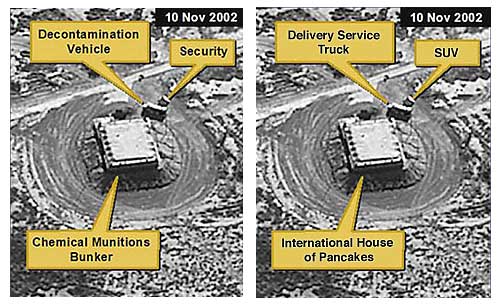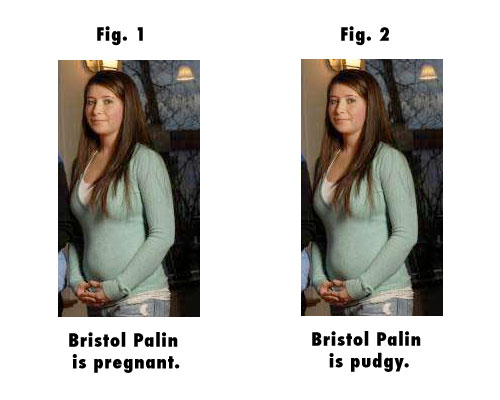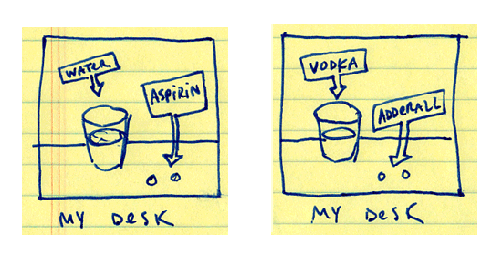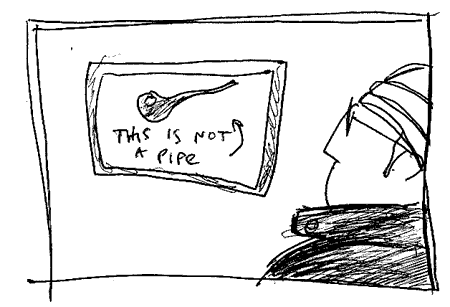
Yesterday, I was thinking about telling a story in pictures without words, and so today, in the aftermath of all the Sarah Palin pregnancy conspiracy theory madness, I started thinking about telling a story with words added to pictures.
The documentary filmmaker Errol Morris had it nailed in his NYTimes article, “Photography As A Weapon,” about photoshopping, forgeries, image processing, captions (and John Heartfield and King Geedorah!):
Doctored photographs are the least of our worries. If you want to trick someone with a photograph, there are lots of easy ways to do it. You don’t need Photoshop. You don’t need sophisticated digital photo-manipulation. You don’t need a computer. All you need to do is change the caption.
I don’t know what these buildings were really used for. I don’t know whether they were used for chemical weapons at one time, and then transformed into something relatively innocuous, in order to hide the reality of what was going on from weapons inspectors. But I do know that the yellow captions influence how we see the pictures. “Chemical Munitions Bunker” is different from “Empty Warehouse” which is different from “International House of Pancakes.” The image remains the same but we see it differently.
Change the yellow labels, change the caption and you change the meaning of the photographs. You don’t need Photoshop. That’s the disturbing part. Captions do the heavy lifting as far as deception is concerned.
If you read through this Daily Kos piece, the writer presents pictures of Palin at various stages of her pregnancy looking thin and trim as “evidence” that she wasn’t really pregnant with her fifth child, but it was her daughter, Bristol, who was pregnant. The article is simply a list of photographs with captions—and the captions control how we read the photographs.
Many folks pointed to this picture as evidence of a Bristol Palin “baby bump”:

A picture which would otherwise be an innocuous portrait of a nice-looking family is turned into a sinister conspiracy by the words, or caption, adjacent to it.

The moral of the story is that pictures can say whatever we want them to say, provided we use the right words.
The power of captions can be used for good, or it can be used for evil. For a cartoonist, it’s a potent weapon, which can take any drawing and turn it in many different ways. Take this hasty doodle:

Depending on which captions I use, you’ll get a different picture of who I am, yes? In comics, it seems, the old creative writing adage “show don’t tell” is useless—you can certainly tell as much as you show, show what you tell, or tell what you show.

I’d love to hear your own thoughts on the use of captions in the comments below. I also recommend taking a look at Derik Badman‘s article, “Text In Comics.”
After reading this post, Meghan pulled out these pages of John Berger’s WAYS OF SEEING:
Wanted to also note that Derik just made a cool post along the same lines, and he also questions the whole “Show Don’t Tell” cliche (he used this Dash Shaw panel from BOTTOMLESS BELLY BUTTON as illustration)
Weird we both posted on this on the same day! I love your water/vodka panels. A great example of using text to supplement images. It take some amount of more panels to show that the clear stuff in the cup is vodka rather than water.
Interesting stuff!
I think the phenomenon might also show itself with ‘novel into film’. You read a book and it conjures pictures in your head– characters and places. Then you see the film inspired by the novel. Pulling the book out again, all the original pictures in your head have changed, even though the words are exactly the same.
Although that’s perhaps less interesting.
Actually, that’s a good point. As I mentioned a couple posts ago, my mother HATES music videos. The reason is that she gets her own picture of a song in her head when she hears a song on the radio. Then, when she sees the video, it ruins it — the video is never better than her imagination, and it forever taints her image of the song.
Just as there are consequences to adding words to pictures, so are there consequences to adding pictures to words.
Austin, As a Marcel Duchamp scholar, ( toutfait.com, marcelduchamp.net ) AND a media ethics investigator, I really appreciated this post. Thank you.
At Stinkyjournalism.org, we consider fake or distorted captions, staged subjects in scene and other undisclosed manipulations –in addition to photoshop–as all part and parcel of the same “fauxtography”.
Marcel Duchamp (some with Man Ray)did numerous altered photos using the standard set of photo tricks known since the beginning of photography. Go here to read more and see examples of Duchamp’s trick photography. He even made himself a ghost figure with a multiple exposure technique circa 1916-17.
The key to your examples is not the selective choice of facts, but a choice between captioning a truth or a lie, eg. The glass is vodka OR it is not. The belly fat is a baby bump or it is not.
I am going post this piece in our StinkyJournalism.org Media pics. So thanks again
BTW. Loved your drawing of “This is not a pipe”! I about to publish an investigation about a fake history published in the The New Yorker and could use a smart cartoon(ist)? Please contact me rrs@asrlab.org if interested.
Bye for now, Rhonda
This is one of the best things you’ve put on here, an amazing observation.
Rhonda: Thanks for the links! I will check them out. And you’re right: it’s about truth–what the truth is, and whether you tell it. That is, if you know what’s true and what’s a lie…
Chris: Thanks for the kind words!
It’s true. I learned about this when I studied media – my teacher asked us to cut random things out of a newspaper and put it under a picture. Some were eerily apt. Do you think a great deal of thought goes in to captions? When I wrote for a newspaper, I’d literally just type whatever I thought the image showed. Usually the caption was very literal. I guess it’s one of those things that gives you away – like involuntary body language.
This actually came up at my job yesterday.
A client wanted more photos on a website and she wanted them to rotate randomly on every page.
I explained to her that if you put a picture on a webpage, you want the picture to some way strengthen, expand, or comment on the webpage as a whole, and the only way to do this was with a caption that is not just descriptive, but also illuminates the significance of the picture. If you have a bunch of pictures randomly rotating on a page, it says nothing — it’s just ornamentation/decoration.
Of course, ornamentation is what most clients want. More graphics. More colors. “Make it pretty.” Make it bigger…
…which is when you hand them some MAKE MY LOGO BIGGER cream.
Speaking of captions, LOOK at all the captions in this recent Lynda Barry comic!
Indexed by Jessica Hagy at VizThink ‘09
This is a great little presentation by Jessica Hagy (indexed) on the importance of captions:
Spoken like a true copywriter!
She also goes on to talk about stock photos, and how stock photos can be used to sell anything:
Well worth checking out, as Hagy is right: a good portion of the VizThink community is all about “if only we find the perfect, simple image, all communication problems will be solved!” Should stir up some folks.
(PS. Until the end, I didn’t realize that Tom asked a question by me.)
Dig “I Lego NY” by Cristoph Niemann — brilliant, funny use of captions:
Jonathan Bass has an exercise he gives his students in his “Composing Graphic Narratives” class at Rutgers based on this post:
Cool!